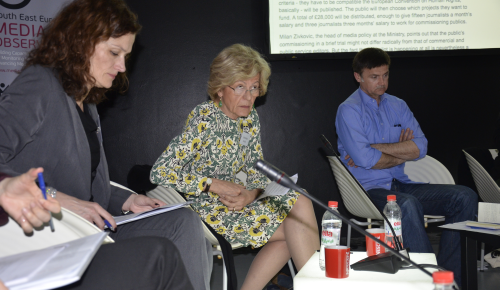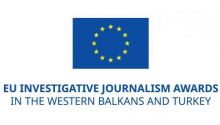Learning lessons from good practices in protection of media integrity, roundtable discussion held in Sarajevo
Numerous watchdog reports, including extensive research conducted within the South East European Media Observatory project, have warned of sharp deterioration of media integrity in the region in recent years. More often than not, media owners and editors are part of a web of clientelist relationships among interest groups that have captured levers of influence in nearly all walks of public life. While old types of pressure (such as violence and threats against journalists, outright bans and draconian court verdicts) still occur, omnipresent are forms of pressure aimed at generating “soft censorship”. But amidst the most frequently highlighted problem areas affecting media integrity (such as non-transparent ownership; misapplication of legislation; non-transparent “state advertising” or politically-controlled commercial advertising), there have also been examples of good practice in guarding media freedoms.
The regional roundtable titled Learning lessons from good practices in protection of media integrity gathered media sector experts and practitioners from across the region. Brankica Petković, the lead researcher of the SEE Media Observatory project, introduced the theme by presenting a case study of examples of positive media practice. The study, conducted within the project, singled out six outlets that, despite many obstacles, manage to practice journalism of high integrity. Žurnal, CIN, BIRN, Insajder, Novosti and Buka share a number of common features. While some conduct a limited volume of commercial activities, they are all essentially non-profit entities sustained through donations. (In fact, the researchers did not identify a single example of good media practice among commercial outlets or public service broadcasters). Their operations were established after the 1990s. Their founders and leading journalists are in all cases extremely dedicated professionals intent on proving that credible public service journalism is still possible.
The study, conducted within the project, singled out six outlets that, despite many obstacles, manage to practice journalism of high integrity; they are all essentially non-profit entities sustained through donations
The study also highlighted some practices of the Croatian Ministry of Culture between 2011 and January 2016 as a positive example of media policy. At the roundtable, Milan F. Živkovic, who served as a media policy adviser at the ministry, explained the main measures taken in this period. The dramatic fall in media revenues after 2008, which resulted in huge job losses in the media sector (including 350 laid-off journalists), motivated a number of ad hoc measures, including a scheme to support non-profit outlets from lottery funds; a pilot program to provide support for journalism projects conducted by individual reporters; and an expansion of the electronic media pluralism fund to encompass non-profit outlets, including those operating only online. According to Živkovic, these measures were also informed by the strong growth trend in the non-profit media sector and various schemes to provide it with public support implemented elsewhere in Europe and beyond. In parallel, the ministry proposed a set of long-term measures (“39 measures for democratic media”) aimed at brining about systemic changes in the sector.
Positive example of media policy intoruced by Croatian Ministry of Culture between 2011 and January 2016 recently reversed
The outcome of this good work, however, is in the balance as the new Croatian government seems determined to limit, rather than expand, media freedoms.
Mirjana Rakić, director of Croatia’s electronic media regulator, spoke of her experiences of government change. While nominally an independent body in charge of implementing what, according to Rakić, is sound media legislation, the regulator found itself under enormous, ideologically motivated pressure from the new government. A recent episode when the regulator took a local TV of air for three days following a hate speech rant by one of its presenters was a case in point. While media and human rights communities in the country and internationally commended the regulator’s measure, the new government in effect supported the sentiments expressed by 8,000 extremist protesters who mobbed and threatened Rakić after she announced the sanction. “We lost our independence overnight,” said Rakic.
Reports by Serbia’s Anti-Corruption Council featured dramatic findings, but the government has largely ignored them; Media and civil society did not provide a meaningful response, said Milićević
The Media Observatory case study also identified the work of Serbia’s Anti-Corruption Council as a positive example of tackling media issues by a government advisory body. Miroslav Milićević, vice-president of the council, spoke of three major probes into media issues conducted by the body between 2011 and 2015. The wide-ranging reports looked at different channels of control of media outlets in the country, including non-transparent ownership, misuse of “state advertising” and “tabloidization” of the media. But while the reports featured dramatic findings, all meticulously researched, as well as specific recommendations, the government has largely ignored them. Rare interactions with ministers also revealed a lack of grasp of freedom of expression issues among government officials (with a minister at one meeting dismissing the notion of self-censorship as “psychological category”). Even more frustrating, according to Miličević, has been the absence of a meaningful response from the media and civil society, with very little follow-up scrutiny of the issues highlighted in the reports.
In the subsequent panel discussion, experts and practitioners from the regulatory and advisory bodies in the region called attention to short-lived instances of good media practice. Helena Mandić, assistant head of broadcasting at Bosnia’s Communications Regulatory Agency, noted that positive developments within and in relation to the media sector in the region seem like exceptions that prove the rule. She recalled how Bosnia’s regulator used to be seen as a trailblazer in electronic media regulation in the region only to gradually fall victim to increasing political interference in its work.
On the other hand, additional positive practices were mentioned. According to Lutfi Dervishi, a media expert from Albania, BIRN’s good work inspired other journalists to start websites dedicated to investigative journalism. Their sustainability and independence are in question, though. Jadranka Vojvodić, deputy director of Montenegro’s electronic media regulator, also highlighted a number of positive examples of media practice, such as the work of the Fund for Assistance to Commercial Radio Broadcasters, but opined that the government is generally unwilling to give up its influence over the media.
Good work by BIRN inspired other journalists to start websites dedicated to investigative journalism, said Dervishi
Snežana Trpevska, a journalism professor from Skopje, explained how in recent decades the Macedonian media sector went through different phases. The first was characterised by bad legislation and relatively good practice. The second saw the EU membership candidate acquire good media legislation, while falling into bad media practices. Currently, the country’s media sector is a key part of a clientelist governing system characterised by systemic corruption, with large-scale violations of media freedoms and editorial principles.
An important message from the roundtable is that, while pressures on media freedoms and integrity are likely to further intensify, examples of positive media practice are far from negligible and are certainly capable of inspiring similar efforts. Financial and editorial sustainability of non-profit outlets will be a key battleground in the coming years. The experience of the previous Croatian government with schemes of channelling public funds to non-profit, public service journalism will be valuable, even if their achievements are temporarily reversed.
Photos from the event are available at the Facebook page of the SEE Media Observatory, here.




